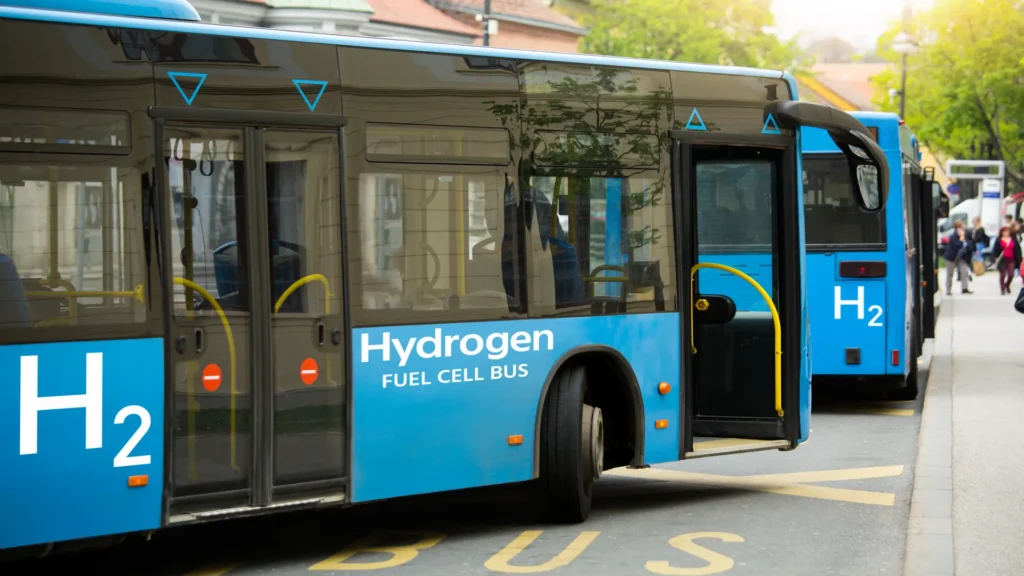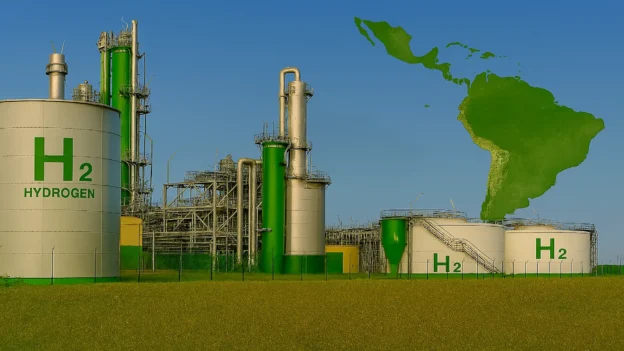Can Latin America really become the global epicenter of green hydrogen, or are we simply witnessing another episode of optimism built on shaky ground? The question is not minor, especially when the numbers paint a tempting scenario: a regional market valued at just USD 101.28 million in 2024 could scale up to USD 3.24 billion by 2033, with a staggering annual growth rate of 46.97%, according to a 2024 IMARC Group report.
The context is as fascinating as it is unsettling. While Chile promises USD 3.3 billion in investments in this sector, the uncomfortable fact is that less than 20% of the more than 40 projects announced have secured financing. The region stands at a crossroads where spectacular promises coexist with structural bottlenecks.
Economic fundamentals: Real advantages or Illusions?
The cost equation that could flip the board
Latin America holds strong cards on the table. Renewable electricity here is not only abundant but also cheap: the Atacama sun translates into some of the lowest solar costs on the planet, while Patagonian winds blow with a force capable of achieving wind capacity factors above 60%.
However, having cheap renewable energy does not guarantee dominance. This industry requires massive capital investments, complex supply chains, and, above all, confidence that demand will pay the bill. Take Chile, for instance, where announced investments hover around USD 56 billion, nearly a third of its GDP (Central Bank of Chile, 2024). Impressive? Yes. Frightening? Also yes, because the uncertainty lies in whether those investments will deliver profitability and ROI in the medium term.
Brazil: A renewable power house without takeoff
With more than 80% of its electricity matrix sourced from renewables, Brazil seems to start this race with a huge advantage. However, when diving into the details, the real challenge is not in generating clean energy but in turning that base into a consolidated industrial ecosystem. That’s the dilemma and the stumbling block: how to move from experimental pilots to a commercially viable industry in a country where local demand has yet to take off. The natural solution seems to be exports, but then a new risk arises: are we not creating external dependence disguised as success?
The invisible bottleneck
Beyond production: Infrastructure and hiddentransportation costs
Producing green hydrogen, yes, but how to start? The real headache appears with the logistics of storing, transporting, and transforming it into derivatives such as ammonia or methanol. A seemingly simple question arises: are ports like Valparaíso, Santos, or Cartagena ready to handle massive exports? The truth is, they are not. Adapting them to production based on demand requires specialized terminals with cryogenic refrigeration and safety protocols that cost over USD 500 million per facility. And those costs, curiously, almost never appear in optimistic analyses.
The pipeline network
Mexico and Colombia dream of distribution networks, but hydrogen does not forgive improvisation. This gas is corrosive and requires special materials, raising investments by up to 40% compared to conventional natural gas pipelines. The uncomfortable question is whether governments are ready to absorb this expense, or if they are betting—perhaps naively—that private capital will do all the heavy lifting. Either way, building a long-distance pipeline requires a planning process that, from design to execution, installation, and maintenance, carries significant costs.
Regulatory frameworks and agreements: Between ambition and aw
Chile: A Model of International Financing
The Chilean case is fascinating because it goes beyond speeches. The IDB approved a USD 400 million loan within a USD 1 billion fund (CORFO, 2023). This scheme blends multilateral organizations, the European Union, and local funds. The big question: is it replicable in other countries of the region? The answer seems to lie in the institutional solidity and regulatory credibility that Chile currently has—assets that not all of its neighbors can display.
MOUs: How real are Tese marriages?
One of the administrative procedures frequently used in these situations are Memorandum of Understanding (MOUs). Countries like Germany, the Netherlands, and Japan have already signed numerous agreements in Latin America. However, experience shows that fewer than 30% of these turn into definitive contracts.
In such a technical and costly industry, this percentage may be even lower, since many MOUs never progress beyond a declaration of intent. The true test for these green hydrogen projects will come when countries and companies move from signing to investing and executing—transforming theory into reality.
Power-to-X: Diversification as strategy
Small-scale projects
Power-to-X projects open another path. Instead of exporting pure hydrogen, the focus shifts to higher value-added derivatives: green ammonia for fertilizers, methanol for ships, synthetic fuels for airplanes. For example, Peru has been exploring applications in sustainable mining for some time. An orthodox approach, perhaps, but more grounded and with potential for local impact and sustainable economic growth.
Public transport: Trials in motion
Colombia and Mexico are already testing hydrogen buses. These are small projects, yes, but with advantages: guaranteed demand, controlled operation, and local technical development. The problem remains the cost: each bus is 40% more expensive than its battery-electric counterpart, and refueling infrastructure is much costlier. Still, it is seen as a promising option for city CO₂ reduction plans.

Invisible risks: Geopolitics and technology
Buyer dependence
Here emerges a familiar ghost: becoming exporters of raw materials without capturing added value. If Latin America only sells hydrogen molecules, benefits risk escaping to the Global North, repeating the old extractive patterns seen with oil or minerals such as iron, aluminum, and copper.
Batteries: The silent rival
Meanwhile, electric batteries continue to advance in development and adoption. Their costs have fallen 85% in the last decade and show no sign of stopping. If they achieve greater energy density and lower costs—that is, if they become more efficient and economical—what will happen to hydrogen? For heavy industrial processes it will remain competitive, but in seasonal electric storage, the battle grows increasingly fierce.
Scenario Forecasts 2025–2035
- The optimistic scenario: A favorable outcome for all would be that the region captures 15% of the global market by 2035, with exports reaching up to USD 30 billion annually. In the short term, if conditions are favorable, Chile and Brazil are expected to lead with 5 million tons each, while Mexico and Colombia consolidate as sectoral hubs.
- The pessimistic scenario: Conversely, the worst-case scenario would be that most projects stall at the announcement phase. Only 20% would reach final investment. Regional production would not exceed 500,000 tons by 2035. Not the end of the world, but a major missed opportunity if regulatory frameworks and technical capacities are not strengthened.
Conclusions
Latin America has resources, potential markets, and even some initial success stories. But without solid infrastructure, reliable regulatory frameworks, and a strategy of regional integration, the risk is ending up with yet another unfulfilled energy promise. The clock is ticking: the next three years will be decisive. Green hydrogen in Latin America is walking a tightrope—it could become the great engine of change or end up as another energy mirage. The region holds powerful cards: abundant sun and wind, enviable renewable energy costs, and an international community eager to diversify its sources.
Chile and Brazil already show muscle with significant investments. But the other side cannot be ignored: most projects are still unfinanced promises, and the necessary ports and pipelines exist only on paper. The real leap will only happen if governments and the private sector manage to connect this resource with local industries, create clear rules, and think long term. Otherwise, hydrogen will be more smoke than energy, more speech than transformation.
References
- Central Bank of Chile. (2024). Green hydrogen in Chile: Demand and investment outlook. https://www.bcentral.cl/web/banco-central/w/hidrogeno-verde-chile
- Inter-American Development Bank. (2022, October 5). The future of green hydrogen: A tremendous opportunity for Latin America and the Caribbean. Energy for the Future. https://blogs.iadb.org/energia/es/el-futuro-del-hidrogeno-verde-una-tremenda-oportunidad-para-america-latina-y-el-caribe/
- Production Development Corporation. (2023, June 19). Government announces USD 1 billion fund for the development of green hydrogen in Chile. https://corfo.cl/sites/cpp/sala_de_prensa/nacional/19_06_2023_fondo_hidrogeno_verde
- H2 Business News. (2025, June 11). The development of green hydrogen in Latin America: Key figures and trends. https://h2businessnews.com/el-desarrollo-del-hidrogeno-verde-en-america-latina-cifras-clave-y-tendencias/
- IMARC Group. (2024). Latin America green hydrogen market size and share report [2025–2033]. https://www.imarcgroup.com/report/es/latin-america-green-hydrogen-market
- Ministry of Energy of Chile. (2024). Chile allocates USD 50 million for green hydrogen projects. https://energia.gob.cl/noticias/nacional/chile-adjudica-usd50-millones-para-proyectos-de-hidrogeno-verde
- Ministry of Energy of Chile. (2024). Green Hydrogen Action Plan 2023–2030. https://www.planhidrogenoverde.cl/wp-content/uploads/2024/01/Plan-H2V-Consulta.pdf
- Moccasin, M. (2024, November 17). The green future: Latin American hydrogen generation market 2024. Medium. https://medium.com/@merridiemoccasin/el-futuro-verde-mercado-latinoamericano-de-generaci%C3%B3n-de-hidr%C3%B3geno-2024-e95bcf3766b2


